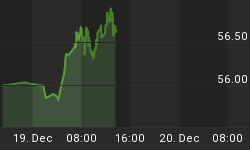The probabilities of a near-term loosening of the Chinese yuan peg to the U.S. dollar are rising. Firstly, the Chinese economy, after experiencing a "soft patch" of growth in the middle of 2004 after the government implemented some restrictive economic policies, has resumed strong growth. China's overall trade surplus has surged at the same time as domestic demand remains robust. Therefore, inflationary pressures, after having abated in the second half of 2004, are starting to build again. Also, real estate speculation is rampant due to relatively low interest rates and the perceived undervaluation of the yuan. By allowing the yuan to edge higher vs. the dollar, some of the inflationary pressures, both for goods/services and real estate, would be relieved somewhat. Also, by allowing more variability in the foreign exchange value of its currency, the Chinese central bank would regain more monetary policy latitude. So, for domestic economic policy reasons, there is a rationale for the Chinese government to ease the peg of the yuan vs. the dollar. Secondly, international political pressure is building for the Chinese to "free the yuan." U.S. economic growth appears to be in the process of slowing with trade and current account deficits continuing to widen. Economic growth also has stalled in the eurozone with textile imports from China increasing. The U.S. Congress is threatening protectionist legislation targeted at China. The EU also is rattling its protectionist sword with regard to China. The Bush administration, perhaps in an effort to head off congressional protectionist legislation, has stepped up it rhetoric with respect to the need for some near-term revaluation of the yuan. Thus, both for domestic economic purposes and external political purposes, the time would seem propitious for the Chinese government to allow some relaxation of the tight peg of the yuan to the dollar.
It is highly unlikely that the Chinese authorities would initially allow the yuan to float freely. Rather, the first step probably will be to link the yuan to some basket of currencies, including the dollar. Then the yuan would be allowed to "crawl" up or down vs. this basket of currencies. The initial effective revaluation of the yuan vs. the dollar would likely be between 5% to 10%.
Because of greatly increased trade activity between the Chinese and other Asian economies, other Asian monetary authorities have limited the appreciation of their currencies vs. the dollar so as to maintain competitiveness with China. These other Asian countries have incurred some of the economic costs that China has in trying to prevent their currencies from appreciating vs. the dollar. Therefore, if China were to allow the yuan to appreciate vs. the dollar, other Asian monetary authorities would also allow some appreciation of their currencies vs. the dollar. A 5% to 10% depreciation of the dollar vs. the Chinese yuan would only marginally slow down the widening of the U.S. trade and current account deficits. However, when accompanied by a depreciation of the dollar vs. Asian currencies in general, a noticeable slowing in the widening of the U.S. external deficit would be expected. The euro would participate to a lesser extent in an appreciation vs. the dollar as Asian central banks diversified some of their current and future international reserves into euro-denominated assets.
The general depreciation of the dollar vs. Asian currencies would put upward pressure on U.S. import prices and U.S. Treasury yields. Approximately one-third of total U.S. imports of goods are from Pacific Rim economies. This is the single largest regional import source for the U.S. The dollar has depreciated least vs. Asian currencies since the start of its descent in 2002. Thus, a depreciation of the dollar vs. Asian currencies would likely have a larger impact on import prices than heretofore seen. Foreign central banks tend to be much less "price-sensitive" in their purchases of financial assets than do private investors. Foreign official accounts, largely Asian foreign official accounts, purchased a net $290 billion of U.S. government and agency securities in 2004. The principal motivation for these purchases was to prevent their currencies from appreciating vs. the dollar. If Chinese and other Asian monetary authorities take a more relaxed approach to currency management, then foreign official purchases of U.S. securities is likely to slow, which, all else the same, would put upward pressure on Treasury yields as more price-sensitive private investors would have to purchase the excess. Also, the higher import prices resulting from dollar depreciation vs. Asian currencies would add to inflationary pressures in the U.S. This could put upward pressure on U.S. interest rates via an increase in the inflation premium component of interest rates.















